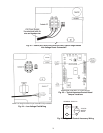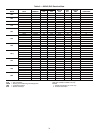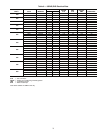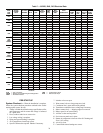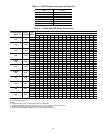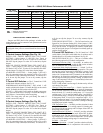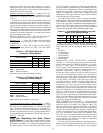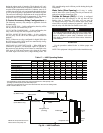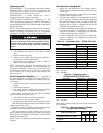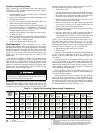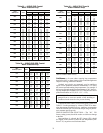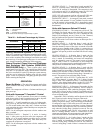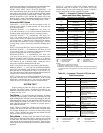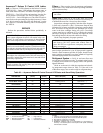
31
boilerless operation mode, only the compressor is used for
heating when FP1 is above the boilerless changeover tempera-
ture set by switch 8 below. Select ON for normal operation or
select OFF for boilerless operation.
Boilerless Changeover Temperature
— Switch 8 on S1 pro-
vides selection of boilerless changeover temperature set point.
Select OFF for set point of 50 F or select ON for set point
of 40 F.
If switch 8 is set for 50 F, then the compressor will be used
for heating as long as the FP1 is above 50 F. The compressor
will not be used for heating when the FP1 is below 50 F and the
compressor will operates in emergency heat mode, staging on
EH1 and EH2 to provide heat. If a thermal switch is being used
instead of the FP1 thermistor, only the compressor will be used
for heating mode when the FP1 terminals are closed. If the FP1
terminals are open, the compressor is not used and the control
goes into emergency heat mode.
DIP SWITCH BLOCK 2 (S2) — This set of DIP switches is
used to configure accessory relay options. See Fig. 20.
Switches 1 to 3
— These DIP switches provide selection
of Accessory 1 relay options. See Table 14 for DIP switch
combinations.
Switches 4 to 6
— These DIP switches provide selection
of Accessory 2 relay options. See Table 15 for DIP switch
combinations.
Table 14 — DIP Switch Block S2 —
Accessory 1 Relay Options
LEGEND
NOTE: All other DIP switch combinations are invalid.
Table 15 — DIP Switch Block S2 —
Accessory 2 Relay Options
LEGEND
NOTE: All other switch combinations are invalid.
Auto Dehumidification Mode or High Fan Mode — Switch 7
provides selection of auto dehumidification fan mode or high
fan mode. In auto dehumidification fan mode the fan speed
relay will remain off during cooling stage 2 if terminal H is
active. In high fan mode, the fan enable and fan speed relays
will turn on when terminal H is active. Set the switch to ON for
auto dehumidification fan mode or to OFF for high fan mode.
Switch 8
— Not used.
Units with Modulating Hot Water Reheat
(HWR) Option —
A heat pump equipped with Hot Water
Reheat (HWR) can operate in three modes: cooling, cooling
with reheat, and heating. The cooling and heating modes are
like other Aquazone™ water source heat pumps. The reversing
valve ("O" signal) is energized in cooling, along with the com-
pressor contactor(s) and blower relay. In the heating mode, the
reversing valve is deenergized. Almost any thermostat will
activate the heat pump in heating or cooling modes. The
Deluxe D microprocessor board, which is standard with the
HWR option, will accept either heat pump (Y,O) thermostats
or non-heat pump (Y,W) thermostats.
The reheat mode requires either a separate humidistat/
dehumidistat or a thermostat that has an integrated dehumidifi-
cation function for activation. The Deluxe D board is config-
ured to work with either a humidistat or dehumidistat input to
terminal “H” (DIP switch settings for the Deluxe D board are
shown in Table 16). Upon receiving an “H” input, the Deluxe
D board will activate the cooling mode and engage reheat.
Table 16 — Humidistat/Dehumidistat Logic and
Deluxe D DIP Switch Settings
Table 17 shows the relationship between thermostat input
signals and unit operation. There are four operational inputs for
single stage units and six operational inputs for dual stage
units:
•Fan Only
• Cooling Stage 1
• Cooling Stage 2
• Heating Stage 1
• Heating Stage 2
• Reheat Mode
MODULATING HWR APPLICATION CONSIDER-
ATIONS — Unlike most hot gas reheat options, the mod-
ulating HWR option (RVC,RHS,RVS,RDS only) will oper-
ate over a wide range of entering-water temperatures
(EWTs). Special flow regulation (water regulating valve) is
not required for low EWT conditions. However, below 55 F,
supply-air temperatures cannot be maintained at 72 F
because the cooling capacity exceeds the reheat coil capac-
ity at low water temperatures. Below 55 F, essentially all
water is diverted to the reheat coil (no heat of rejection to
the building loop). Although the HWR option will work fine
with low EWTs, overcooling of the space may result with
well water systems or, on rare occasions, with ground loop
(geothermal) systems (NOTE: Extended range units are
required for well water and ground loop systems). Since
dehumidification is generally only required in cooling, most
ground loop systems will not experience overcooling of the
supply-air temperature. If overcooling of the space is a con-
cern (e.g., computer room well water application), auxiliary
heating may be required to maintain space temperature
when the unit is operating in the dehumidification mode.
Water source heat pumps with HWR should not be used as
makeup air units. These applications should use equipment
specifically designed for makeup air.
HWR COMPONENT FUNCTIONS — The proportional
controller operates on 24 VAC power supply and automatically
adjusts the water valve based on the supply-air sensor. The
supply-air sensor senses supply-air temperature at the blower
inlet, providing the input signal necessary for the proportional
control to drive the motorized valve during the reheat mode of
operation. The motorized valve is a proportional actuator/three-
way valve combination used to divert the condenser water
from the coax to the hydronic reheat coil during the reheat
mode of operation. The proportional controller sends a signal
to the motorized valve based on the supply-air temperature
reading from the supply air sensor.
The loop pump circulates condenser water through the hy-
dronic reheat coil during the reheat mode of operation (refer to
Fig. 28). In this application, the loop pump is only energized
ACCESSORY 1
RELAY OPTIONS
DIP SWITCH POSITION
123
Cycle with Fan On On On
Digital NSB Off On On
Water Valve — Slow Opening On Off On
OAD On On Off
NSB — Night Setback
OAD — Outside Air Damper
ACCESSORY 2
RELAY OPTIONS
DIP SWITCH POSITION
456
Cycle with Fan On On On
Digital NSB Off On On
Water Valve — Slow Opening On Off On
OAD On On Off
NSB — Night Setback
OAD — Outside Air Damper
Sensor 2.1
2.2 2.3 Logic
Reheat
(ON) - H
Reheat
(OFF) - H
Humidistat
Off Off Off Reverse 0 VAC 24 VAC
Dehumidistat Off On Off Standard 24 VAC 0 VAC



